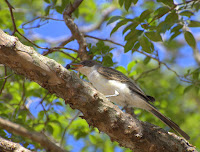FORK-TAILED FLYCATCHER
FORK-TAILED FLYCATCHER – (Tyrannus savana) – (See images below)
DESCRIPTION: The Fork-tailed Flycatcher male has a black cap, light grey back midway down, and about a third of the way down for the wings. Rest of the wings, back and tail are dark grey. Tail is deeply forked. Under parts are white, including underwings. Eyes, bill, legs and feet are black. Sexes are similar, except for the tail length. Juveniles’ tail is shorter than that of female, and have duller colors. Bird length is about 40 cm (16 inches) for the male, and its tail includes about two-thirds of that length. Female is around 30 cm (12 inches) including the tail.
VOICE: https://www.xeno-canto.org/species/Tyrannus-savana
NAME: ‘Flycatcher’ refers to the bird’s feeding behavior (see Diet below). ‘Fork-tailed’ refers to the tail shape. Latin genus name ‘Tyrannus’ means ‘tyrant’ or ‘king’. Latin species name ‘savana’ is from Spanish ‘sabana’, a ‘plain’, in reference to the bird’s habitat.
HABITAT: Fields and meadows with trees.
DIET: Insects caught on the fly, also some fruit.
NESTING: Nest is built in a tree. About three white eggs are laid, incubated by female.
DISTRIBUTION: Year-round resident in south parts of Mexico, Central America and South America (except the Andes region and the east region of Brazil). Regularly wanders north into the USA, even Canada.
Distribution Map: https://en.wikipedia.org/wiki/Fork-tailed_flycatcher – /media/File:Tyrannus_savana_map.svg
ON PEI: Does not breed on Prince Edward Island, sightings listed as ‘accidental’ so far. See note below on bird vagrancy.
CONSERVATION: Population widespread, currently not at risk.
NOTES: Flycatchers are part of a genus called ‘Kingbirds’, within the Tyrant Flycatcher family. They are known to aggressively defend their nests and territories, even attacking much larger predatory birds.
This particular species has the longest tail relative to its body length.
Vagrancy: In biology this means an animal going way outside its normal range. For birds, this can happen when there are storms and they get blown off course. On other times, the bird simply wanders in a different direction than usual. Here’s an article about vagrancy in birds.
SIMILAR SPECIES: Scissor-tailed Flycatcher
REFERENCES: https://en.wikipedia.org/wiki/Fork-tailed_flycatcher
https://neotropical.birds.cornell.edu/Species-Account/nb/species/fotfly/appearance
https://identify.whatbird.com/obj/836/behavior/Fork-tailed_Flycatcher.aspx
https://www.maineaudubon.org/news/rare-bird-alert-fork-tailed-flycatcher/
https://birds-of-tobago.blogspot.com/2013/10/fork-tailed-flycatcher.html
DESCRIPTION: The Fork-tailed Flycatcher male has a black cap, light grey back midway down, and about a third of the way down for the wings. Rest of the wings, back and tail are dark grey. Tail is deeply forked. Under parts are white, including underwings. Eyes, bill, legs and feet are black. Sexes are similar, except for the tail length. Juveniles’ tail is shorter than that of female, and have duller colors. Bird length is about 40 cm (16 inches) for the male, and its tail includes about two-thirds of that length. Female is around 30 cm (12 inches) including the tail.
VOICE: https://www.xeno-canto.org/species/Tyrannus-savana
NAME: ‘Flycatcher’ refers to the bird’s feeding behavior (see Diet below). ‘Fork-tailed’ refers to the tail shape. Latin genus name ‘Tyrannus’ means ‘tyrant’ or ‘king’. Latin species name ‘savana’ is from Spanish ‘sabana’, a ‘plain’, in reference to the bird’s habitat.
HABITAT: Fields and meadows with trees.
DIET: Insects caught on the fly, also some fruit.
NESTING: Nest is built in a tree. About three white eggs are laid, incubated by female.
DISTRIBUTION: Year-round resident in south parts of Mexico, Central America and South America (except the Andes region and the east region of Brazil). Regularly wanders north into the USA, even Canada.
Distribution Map: https://en.wikipedia.org/wiki/Fork-tailed_flycatcher – /media/File:Tyrannus_savana_map.svg
ON PEI: Does not breed on Prince Edward Island, sightings listed as ‘accidental’ so far. See note below on bird vagrancy.
CONSERVATION: Population widespread, currently not at risk.
NOTES: Flycatchers are part of a genus called ‘Kingbirds’, within the Tyrant Flycatcher family. They are known to aggressively defend their nests and territories, even attacking much larger predatory birds.
This particular species has the longest tail relative to its body length.
Vagrancy: In biology this means an animal going way outside its normal range. For birds, this can happen when there are storms and they get blown off course. On other times, the bird simply wanders in a different direction than usual. Here’s an article about vagrancy in birds.
SIMILAR SPECIES: Scissor-tailed Flycatcher
REFERENCES: https://en.wikipedia.org/wiki/Fork-tailed_flycatcher
https://neotropical.birds.cornell.edu/Species-Account/nb/species/fotfly/appearance
https://identify.whatbird.com/obj/836/behavior/Fork-tailed_Flycatcher.aspx
https://www.maineaudubon.org/news/rare-bird-alert-fork-tailed-flycatcher/
https://birds-of-tobago.blogspot.com/2013/10/fork-tailed-flycatcher.html
 |
| Fork-tailed flycatcher, by Dario Sanches |
 |
| Fork-tailed flycatcher, Rogier Klappe |
 |
| Fork-tailed flycatcher, by dfaulder |
 |
| Fork-tailed flycatcher on nest, Brasil by Dario Sanches |
 |
| Fork-tailed flycatcher feeding, Brasil by Dario Sanches |